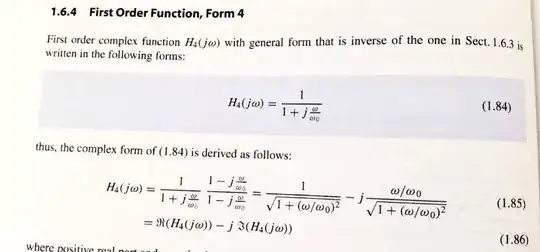I think the author (or, just as likely, the grad students who did the heavy lifting) made mistakes in writing/editing the textbook. It happens far too often.
Not a lot of good proof-readers that can read these materials with understanding. And those that are good, these days anyway, aren't proof-reading but doing something that pays better.
(There was a time when "the rest of us" had better access to the better minds available. But that time is long gone (in the US) since very early in the Reagan Era (1981 and 1982 and 1983, in particular) when several significant changes to public science funding and patent law, for reasons requiring many hundreds of pages to explain, totally changed things here, and forever since.)
Their denominator, shown on the right side as \$\sqrt{1+\frac{\omega}{\omega_{_0}}}\$, is what arrives as the complex magnitude (length of the hypotenuse) of the denominator on the left. That does show up when you take the magnitude:
$$\begin{align*}
\bigg|\:\frac1{1+j\frac{\omega}{\omega_{_0}}}\:\bigg| &= \frac{1}{\left|1+j\frac{\omega}{\omega_{_0}}\right|}=\frac1{\sqrt{1+\left(\frac{\omega}{\omega_{_0}}\right)^2}}
\end{align*}$$
But not when you are trying to put a complex transfer function into the standard mathematical complex form of \$a+b\,i\$.
So,
$$\frac1{1+j\frac{\omega}{\omega_{_0}}}\cdot \frac{1-j\frac{\omega}{\omega_{_0}}}{1-j\frac{\omega}{\omega_{_0}}}=\frac{1-j\frac{\omega}{\omega_{_0}}}{1+\left(\frac{\omega}{\omega_{_0}}\right)^2}=\frac{1}{1+\left(\frac{\omega}{\omega_{_0}}\right)^2}-j\frac{\frac{\omega}{\omega_{_0}}}{1+\left(\frac{\omega}{\omega_{_0}}\right)^2}$$
Which obviously isn't what they produced.
Their answer is easily tested. Just take the magnitude of their right hand side answer and see what you get:
$$\begin{align*}
\bigg|\:\frac{1}{\sqrt{1+\left(\frac{\omega}{\omega_{_0}}\right)^2}}-j\frac{\frac{\omega}{\omega_{_0}}}{\sqrt{1+\left(\frac{\omega}{\omega_{_0}}\right)^2}}\:\bigg| &= \sqrt{\left(\frac{1}{\sqrt{1+\left(\frac{\omega}{\omega_{_0}}\right)^2}}\right)^2+\left(\frac{\frac{\omega}{\omega_{_0}}}{\sqrt{1+\left(\frac{\omega}{\omega_{_0}}\right)^2}}\right)^2}
\\\\
&=\sqrt{\frac1{1+\left(\frac{\omega}{\omega_{_0}}\right)^2}+\frac{\left(\frac{\omega}{\omega_{_0}}\right)^2}{1+\left(\frac{\omega}{\omega_{_0}}\right)^2}}
\\\\
&=\sqrt{\frac{1+\left(\frac{\omega}{\omega_{_0}}\right)^2}{1+\left(\frac{\omega}{\omega_{_0}}\right)^2}}
\\\\
&=\sqrt{1}
\\\\
&= 1
\end{align*}$$
Their claim is that the magnitude is always 1 and independent of the angular frequency \$\omega\$.
I don't think so.
As concernedcitizen says, if this is just an isolated case and not representative of the textbook more generally, then it's just an errata. That happens (though this one isn't exactly a typo, either) from time to time. Nothing is perfect. But if this isn't rare in the textbook, it's time to replace the textbook, the teacher (who should have known better), and the administrative staff for the department (who really should have known better.) In general, this means leaving the institution and finding a better one, as I see it.

sqrt()only comes for the non-squared absolute valued transfer function, e.g. if it were only the real part of (1.85), that would have been |H(w)|. If it happens once, "it happens", but if you say it's consistent throughout the book, then I'd choose a different book. – a concerned citizen Mar 19 '22 at 07:40